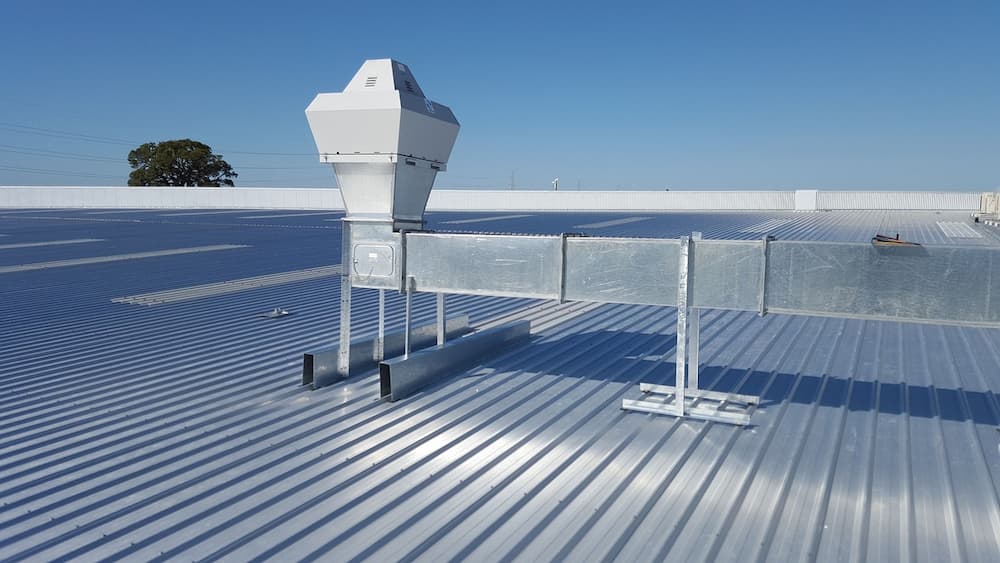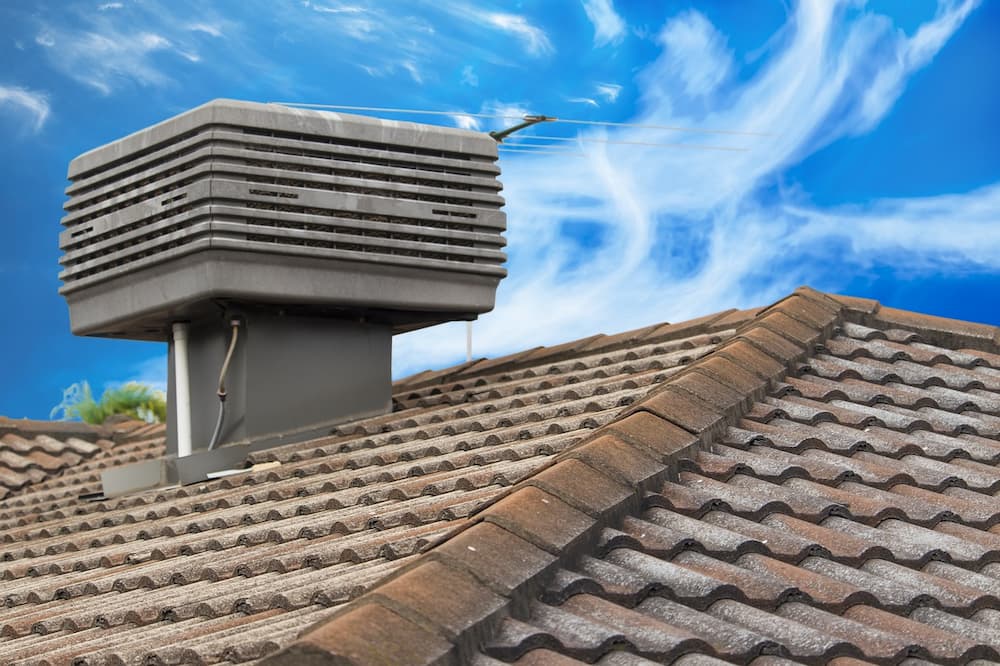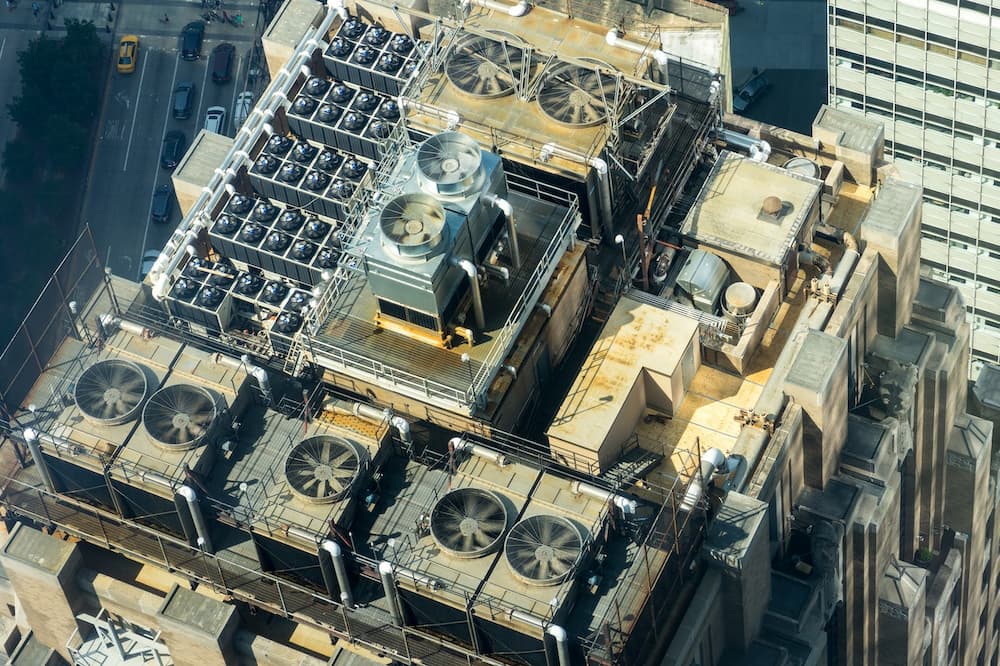Why Install a Rooftop AC Unit on Your Home?
Are you aware of the benefits a rooftop air conditioning system provides? Do you want to enjoy maximum comfort in your home while also saving energy? If so, a rooftop AC unit could be the perfect solution.
Rooftop AC units are packaged systems with all components contained in a single unit. They are normally stationed on the rooftop of commercial buildings (though they can also be installed on a slab at ground level) to provide centralized cooling for the entire building. However, they have also become popular with homeowners who want to take advantage of their energy efficiency, quiet operation, and low cost.
(Rooftop AC Units can damage the roof if not installed and maintained properly. Please ask your roofing contractor about drainage from condensation and keeping your roofing membrane intact to avoid roof repair)

What’s Different About a Rooftop AC System?
While air conditioners on roofs differ slightly from standard HVAC systems (traditional split systems), their main function remains the same. They provide cool air into a space and, in some cases, additional heating capabilities. They both use compressed refrigerant to cool air passing through special coils by means of expansion and contraction.
However, the notable difference lies in the self-contained design of rooftop cooling systems. Unlike standard HVAC systems, which consist of two separate units, air conditioner on roof systems incorporate all components into a single, self-contained unit. Gord from Comfort Wave has more to say about it…
This integrated design eliminates the need for an indoor unit (such as an air handler or furnace) and an outdoor unit (including the condenser and compressor). Instead, all the necessary components – compressor, evaporator, fan, and condenser – are housed within the rooftop unit.
This package unit design not only saves space but also streamlines the installation process. The consolidated configuration allows for efficient cooling performance while maximizing the use of available rooftop space. Below is a cooling cycle of how a rooftop AC system operates:
- Warm air from the surrounding space is drawn into the unit and passed over a set of evaporator coils.
- The refrigerant inside the coil absorbs heat from the air, cooling it down.
- The refrigerant is then compressed and forced through the condenser coil.
- As the refrigerant extracts heat, the air cools down, resulting in a more comfortable temperature.
- A fan within the rooftop unit then blows the newly cooled air into your home or building through the ductwork.
- Meanwhile, the refrigerant, now carrying the absorbed heat, circulates to the compressor.
- At the compressor, the refrigerant undergoes a process that raises its temperature further.
- The heated refrigerant releases the accumulated heat through the unit’s exhaust system.
- The cycle repeats as the cooled air is continuously circulated to maintain a comfortable indoor environment.

Top Advantages of Installing an AC System On the Roof
When you choose to install an HVAC unit on your roof, you can enjoy several significant benefits. Besides the space-saving feature and easy installation, you are also able to enjoy the following:
More efficient cooling performance: The elevated position of rooftop HVAC units enables better airflow and heat dissipation. With unobstructed access to fresh air, the system operates more efficiently, providing optimal cooling or heating performance throughout your home or building. This enhanced airflow contributes to maintaining consistent indoor temperatures.
Increased curb appeal: By placing the HVAC unit on the roof, it remains hidden from view, resulting in a cleaner and more organized appearance. Unlike other types of air conditioning systems, which may have visible indoor or outdoor units, a rooftop HVAC unit keeps the equipment discreetly out of sight. This contributes to the overall aesthetic appeal of your home or building.
Saves space: In addition to the visual and acoustic advantages, installing an air conditioner on the roof maximizes the use of available space. By utilizing the rooftop for installation, valuable indoor space is freed up, which can be particularly advantageous for buildings with limited square footage.
Less noise: The “out of sight” aspect also applies to noise levels. Rooftop HVAC units tend to operate quietly, especially when properly installed and well-maintained. With the main components situated on the roof, any operational noise is isolated, ensuring a peaceful indoor environment.
Reduced risk: By keeping the unit elevated and away from ground-level hazards, it is less susceptible to accidental impacts, vandalism, or other potential damage. This helps to preserve the integrity and functionality of the system, providing peace of mind and avoiding costly repairs or replacements.
Easy access and maintenance: Rooftop HVAC units offer easier accessibility for maintenance and repairs. Service technicians can conveniently reach the unit without entering the living or working spaces, minimizing disruptions for occupants.

Downsides to Owning a Roof Air Conditioner
Rooftop AC units may not be suitable for everyone, and their compatibility with different types of roofs can vary. Weigh the pros and cons carefully before making a final decision.
Potential rooftop damage: The installation of a rooftop air conditioner requires structural modifications and may involve penetration of the roof for proper installation and connection. While professional installers take precautions to minimize potential damage, there is still a risk of leaks or structural issues if not properly addressed.
Installation complexity: Installing a rooftop air conditioner can be more complex and labor-intensive compared to other types of air conditioning systems. The process typically involves lifting heavy equipment onto the roof, ensuring proper anchoring and sealing, and connecting the unit to the necessary electrical and ductwork systems.
Storm Damage: Though rare, air conditioners on roof units remain vulnerable to storm damage caused by factors like lightning strikes, strong winds, and other weather-related hazards.
Higher installation costs: Due to the complexity of the unit and the labor involved, a new unit can cost an average of $5,900 but can be significantly more, with prices reaching as high as $11,000.

Things to Consider Before Installing an AC On Your Roof
Like any major home improvement decision, installing an AC unit on your roof requires careful consideration. There are several factors to evaluate before moving forward with the installation process. Therefore, to determine the suitability of this type of air conditioning system, consider the following factors:
Yard or roof space availability: For optimal performance, condenser units rely on a flat surface that leaves plenty of space around the unit for adequate air circulation. Such conditions may be present in the yard, but if not, the roof may be an ideal location for installation.
Rooftop weight limit: Confirm that your roof can support the added weight of the unit and its components before proceeding with the installation. Their weight can cause damage to the roof’s membrane if the structure cannot handle the additional load.
Weather conditions: Intense heat can put a strain on the unit, necessitating regular inspections and servicing to prevent overheating or damage. Likewise, storms and inclement weather can pose risks to rooftop installations, such as lightning strikes or high winds, which may require additional safeguards and maintenance measures.
Ease of maintenance: Having your rooftop AC unit easily accessible means you can promptly notice if vents are obstructed by leaves and debris. You can also detect leaks or identify subtle sounds that may indicate underlying issues. Conversely, with a rooftop unit, such concerns can easily go unnoticed, potentially leading to complications if they are only addressed during seasonal or annual maintenance checks.
How Much To Invest in a Cooling System On The Roof
As we mentioned before, when it comes to a rooftop AC unit and HVAC systems on the roof, the initial cost of installation can be quite high. The exact figure will depend on factors such as size, transport, contractor rates, etc. Generally speaking, however, you should expect to invest at least $3,800 to $5,500 for a basic setup with one condenser and about 4 to 6 supply grills. In some cases, the cost can go up to as much as $8,000 and beyond.
Ultimately, you will need to figure out the best solution for cooling your home that suits your budget. Investing in a rooftop AC unit can be an expensive and complex endeavor, but it is generally considered to be a good option for larger homes where central air conditioning may not be an option. If you do decide to go down this route, make sure to consult with a professional who can help you in selecting the right size unit and provide guidance on the installation process.
